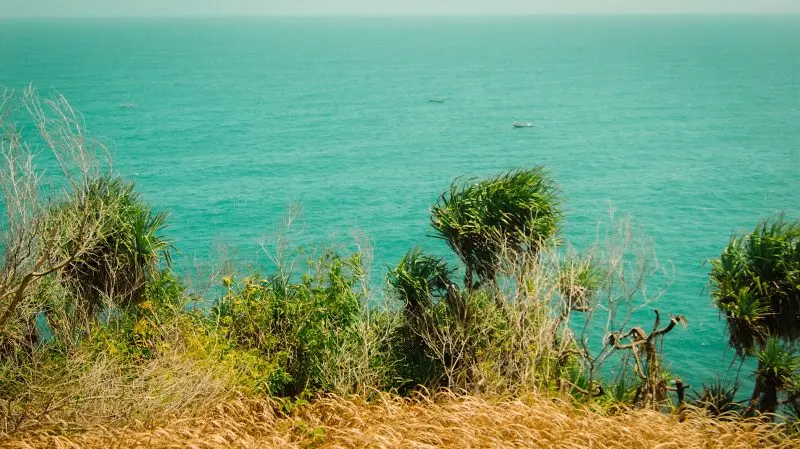Almost three-quarters of the Earth is covered by oceans, giving our planet a pale blue dot appearance from space. However, Japanese researchers have presented compelling evidence suggesting that the oceans of our planet were once green. Moreover, it’s likely that they will change color again in the future. This was detailed in a study published in the journal Nature.
The reason the Earth’s oceans may have looked entirely different in the distant past is tied to their chemistry and the evolution of photosynthesis. This is evidenced by sedimentary rock formations known as banded iron formations, which serve as a kind of chronicle of our planet’s history. These formations were deposited during the Archean and Paleoproterozoic eras, approximately 3.8 to 1.8 billion years ago. Life on Earth at that time was limited to single-celled organisms inhabiting the oceans. The continents were barren landscapes of gray, brown, and black rocks and sediments. Rain falling on continental rocks dissolved iron, which rivers carried into the oceans. Other sources of iron in the oceans included underwater volcanoes. This iron would become significant later on.
The Archean period was a time when the Earth’s atmosphere and oceans were devoid of gaseous oxygen, yet the first organisms capable of harnessing energy from sunlight emerged. These organisms utilized anaerobic photosynthesis, meaning they could perform photosynthesis without oxygen. This led to crucial changes, as the byproduct of anaerobic photosynthesis is gaseous oxygen, which was bound to iron in seawater. Oxygen only existed as a gas in the atmosphere after the iron in seawater could no longer neutralize it. Eventually, early photosynthesis resulted in a “significant oxidative event,” a major ecological turning point. This marked the transition from an Earth largely devoid of oxygen to one rich in oxygen in both the oceans and atmosphere. This transition is recorded in the bands of different colors within the same banded iron formations, showcasing alternating layers of iron deposited without oxygen and oxidized red iron.
So, where does the green color of the oceans come from? At the beginning of their article, the scientists noted that the waters around the Japanese volcanic island of Iwo Jima have a green tint associated with a form of oxidized iron: Fe(III). Blue-green algae thrive in the green waters surrounding the island, as reported by Live Science. Despite their name, blue-green algae are primitive bacteria, not true algae. During the Archean period, the ancestors of modern blue-green algae evolved alongside other bacteria that used divalent iron instead of water as an electron source for photosynthesis. This indicates a high level of iron in the oceans.
During photosynthesis, organisms use pigments (primarily chlorophyll) in their cells to convert CO₂ into organic matter—sugars—using solar energy. Chlorophyll gives plants their green color. Blue-green algae are unique in that they contain the common pigment chlorophyll as well as a second pigment called phycobilin (PEB). Researchers found that genetically modified modern blue-green algae with PEB grow better in green water. While chlorophyll is excellent for photosynthesis in the visible light spectrum we experience today, PEB seems to perform better under green light conditions.
Before the advent of photosynthesis and oxygen, the Earth’s oceans contained dissolved reduced iron (the kind that precipitated without oxygen). The oxygen released with the emergence of photosynthesis during the Archean period eventually led to the oxidation of iron in seawater. Computer modeling has also shown that the oxygen released by early photosynthesis was associated with a relatively high concentration of oxidized iron particles, which tinted the surface waters green. Once all the iron in the oceans was oxidized, free oxygen (O₂) appeared in both the oceans and the Earth’s atmosphere. One of the key takeaways from the study is that pale green distant planet-like dots in space could be indicative of early photosynthetic life.
The changes in ocean chemistry were gradual. The Archean period lasted 1.5 billion years, which is more than half of Earth’s history. It’s likely that the color of the oceans changed slowly over this time and potentially fluctuated. This could explain why blue-green algae developed both forms of photosynthetic pigments. Chlorophyll is best suited for white light, like what we have today. The simultaneous use of green and white light would have provided an evolutionary advantage.
Could the oceans change color again? The lesson from the Japanese scientists’ article is that the color of our oceans is linked to the chemistry of the water and the influence of surrounding life. For instance, the oceans could be purple if the level of sulfur on the planet were high enough. Such levels could occur during intense volcanic activity and low atmospheric oxygen content, leading to the dominance of purple sulfur bacteria. As our Sun ages, it will initially become brighter, resulting in increased surface evaporation and intense ultraviolet radiation. This could spur the rapid development of sulfur bacteria living in deep, oxygen-free waters. Consequently, a plethora of purple, brown, or green hues could emerge in coastal or stratified areas, while the deep blue color of the water would become rare due to a decrease in phytoplankton.
Ultimately, the oceans will completely evaporate as the Sun “expands and engulfs the Earth’s orbit,” the scientists wrote. But that will happen a long time from now. Regardless, the researchers concluded that changes in the color of our oceans are inevitable.

